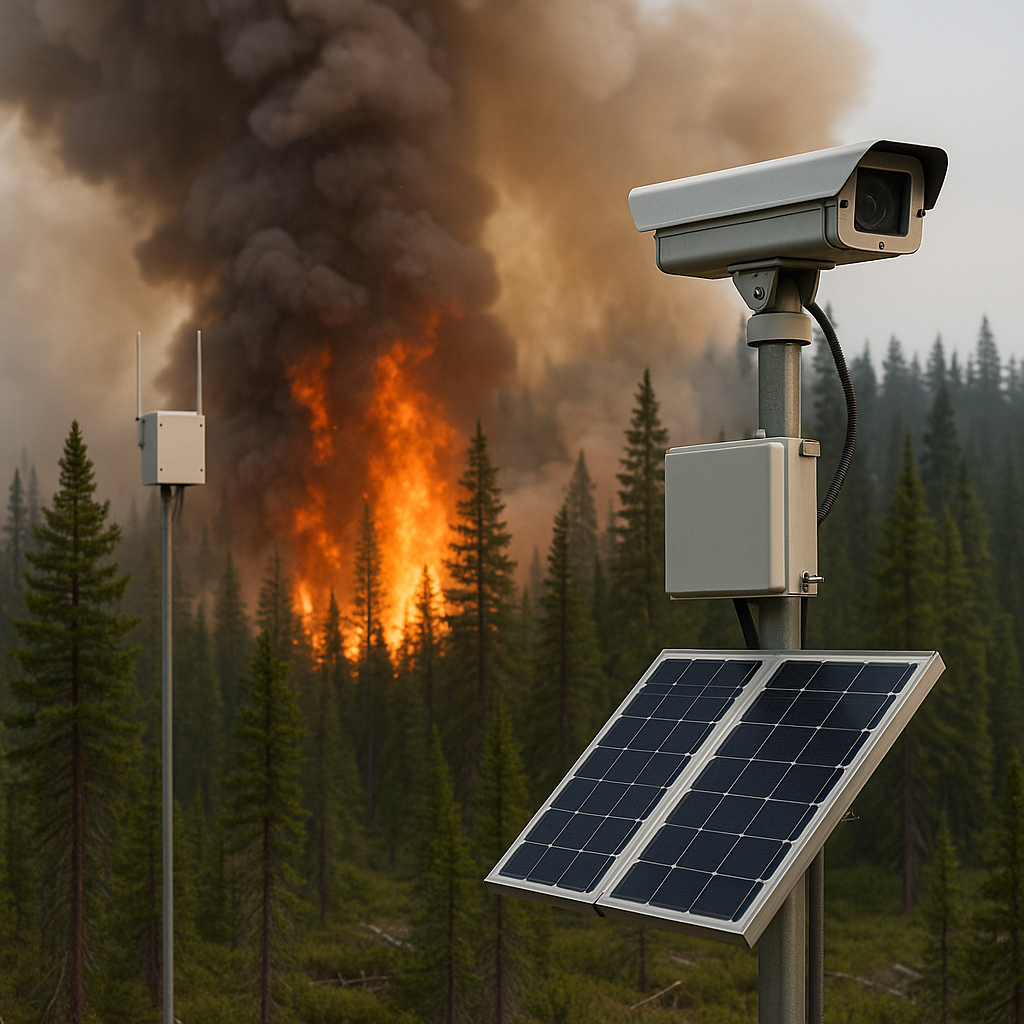AI-driven sensor network could transform wildfire detection in remote areas
Current wildfire detection methods largely depend on satellite imagery, aerial surveillance, and lookout towers, approaches that are either delayed, expensive, or ineffective in sparsely populated terrain. In remote regions, where cellular or wired communication infrastructure is often non-existent, these gaps can allow fires to spread for hours undetected.

Global wildfires are accelerating in intensity and frequency, devastating ecosystems, threatening lives, and overwhelming emergency response systems, especially in regions with limited infrastructure. Traditional fire detection methods, often delayed and resource-intensive, leave remote areas dangerously exposed.
In response to this growing crisis, a new study published in Fire (2025), titled “Optimized Wireless Sensor Network Architecture for AI-Based Wildfire Detection in Remote Areas,” introduces a novel architecture combining wireless sensor networks and artificial intelligence to identify wildfires early and accurately in some of the world's hardest-to-reach zones.
Why existing wildfire detection systems are falling short?
Current wildfire detection methods largely depend on satellite imagery, aerial surveillance, and lookout towers, approaches that are either delayed, expensive, or ineffective in sparsely populated terrain. In remote regions, where cellular or wired communication infrastructure is often non-existent, these gaps can allow fires to spread for hours undetected.
According to the study, conventional wireless sensor networks (WSNs) used for environmental monitoring are often not optimized for wildfire detection. Most existing networks lack the scalability, coverage, and intelligent data processing capabilities needed for large, rugged, and disconnected geographic areas. Energy consumption is another critical limitation; sensors often fail prematurely in remote locations due to power constraints.
Additionally, latency in data transmission and high rates of false alarms in traditional systems reduce reliability and prompt slow or misguided emergency responses. These problems underscore the need for a system that can not only collect environmental data but interpret and act on it in real-time.
How the proposed AI-based WSN architecture works
To address these shortcomings, the study proposes a multi-layered architecture that integrates artificial intelligence with wireless sensor networks to enable early and accurate wildfire detection. The proposed framework relies on a tiered, modular design incorporating sensor nodes, cluster heads, sink nodes, and a centralized AI-powered control center.
At the base level, sensor nodes are deployed in a grid across fire-prone areas. These sensors monitor environmental variables such as temperature, humidity, and the presence of smoke particles. Cluster heads manage and pre-process the data collected by local sensors, filtering out noise and transmitting relevant signals to sink nodes. From there, data is routed to a control station equipped with AI algorithms capable of identifying early indicators of wildfire ignition.
One of the most significant advantages of the system is its use of AI-based classification models, trained to distinguish between actual fire events and environmental anomalies. This dramatically reduces false positives and improves decision accuracy. The AI module continuously learns from new data, making the system increasingly effective over time.
To ensure reliability in harsh conditions, the design emphasizes energy-efficient protocols and fault tolerance. Sensor nodes operate using low-power communication standards like ZigBee, while energy harvesting components (such as solar panels) prolong operational life. The architecture also supports dynamic re-routing of data if a node fails, ensuring continuity in data transmission during critical moments.
Additionally, the network is scalable and modular, meaning it can be expanded or modified to fit different terrains, fire risk levels, or budget constraints. This makes the system adaptable for deployment in forests, national parks, mountain ranges, and other inaccessible fire-prone zones.
What are the broader implications for fire management?
The adoption of such an intelligent wildfire detection system could radically alter fire management strategies in regions most vulnerable to catastrophic burns. By minimizing detection time and maximizing predictive accuracy, firefighting teams can be dispatched faster, with more situational awareness and greater resource efficiency.
The study highlights potential benefits such as reduced loss of biodiversity, prevention of damage to critical infrastructure, and enhanced protection of human lives. In countries where rural communities coexist with wildfire-prone landscapes, early detection systems could also support public safety evacuation protocols.
On a wider scale, the research supports the integration of smart environmental monitoring into national disaster response frameworks. The system's compatibility with cloud-based platforms and satellite telemetry means it can be connected to central fire control units or disaster management centers, enabling unified response coordination.
Moreover, the proposed framework aligns with sustainable development goals by reducing the ecological and economic toll of wildfires, especially in the Global South, where the cost of large-scale aerial monitoring is prohibitive.
The researchers emphasize the affordability and deployability of their design. Unlike satellite systems or manned aerial patrols, the sensor network requires relatively low upfront investment and can be maintained using local technical expertise. With global wildfire seasons becoming longer and more intense, the urgency for cost-effective, intelligent solutions has never been higher.
- READ MORE ON:
- AI wildfire detection
- wireless sensor networks wildfire
- remote area fire monitoring
- smart wildfire detection system
- wildfire early warning system
- AI-based wildfire detection in remote regions
- wireless sensor networks for wildfire prevention
- how artificial intelligence improves fire detection
- climate change and wildfire tech
- wildfire mitigation technology
- FIRST PUBLISHED IN:
- Devdiscourse










